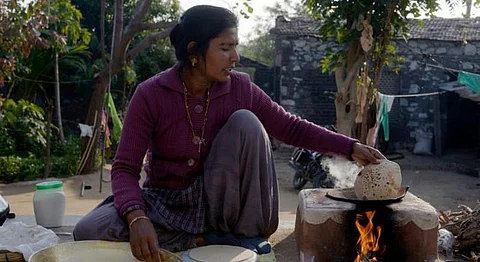
- HOMEGROWN WORLD
- #HGCREATORS
- #HGEXPLORE
- #HGVOICES
- #HGSHOP
- CAREERS
- ABOUT US
- CONTACT US

For documentary photographer Rohit Jain (born in Lalitpur, Uttar Pradesh), ordinary people and their lives are the highest sources of inspiration for creating art. He believes that photography has helped him build a closer bond with people and offered him a glimpse into the empathetic side of human beings.
“I go and meet people. We talk and we have tea. When we are comfortable with each other, I ask them if I can take their photos,” says Rohit in an interview with Homegrown. He makes it clear that it is not just about the photos. Instead, what he really wants to do is to forge a comfortable relationship with people and moreover, instill a certain amount of trust in them. Therefore, he makes sure that his subjects are never photographed without their knowledge, thereby enabling him to maintain a certain kind of dignity in the photos. Taking consent and instilling a sense of agency onto his subjects is an integral part of his photography. However, he agrees that it is sometimes difficult to portray people in difficult circumstances in a dignified manner, since the subjects themselves are too oppressed to even understand what dignity means. It is then that he turns to his creative insights to assess how best he could portray their circumstances, so that the point of view is matter-of-fact and detached. He makes sure there is an objectivity attached to it. The purpose of his work is not to reduce people to their circumstances, but to instill a sense of empathy in the viewer.
A photo by Alixandra Fazzina of an Afghan woman breastfeeding her child, left a huge impact on Rohit, and inspired him in his journey as a photographer. The photo was part of Alixandra Fazzina’s photo story, ‘Maternal Mortality’.
“To be true, I don’t know why this image impacted me and why it is still imprinted in my memory. Sometimes, some images impact us and we don’t always know why,” says Rohit.
Rohit’s favourite subjects are anything that has remained and continue to remain ignored or overlooked in society. Women’s struggles and oppression in a patriarchal society are subjects close to his heart, and something that he wants to shift the focus to.
“Women have to live in veil, they can’t dance as freely, they can’t bathe as freely as men (in villages where washroom aren’t there), and they even can’t laugh in front of men. What right do we have to take away anyone’s freedom?” questions Rohit.
He also feels that exploiting the environment in the name of development is another one of those social evils that needs to be eliminated. His work on Bisalpur Dam in Rajasthan is one such project that he feels would shine the spotlight on how people are being affected by so-called ‘development’ and ‘modernisation’ in today’s day and age. While working on the project he had got in touch with people in the Tonk district of Rajasthan whose houses and land had been submerged in the aftermath of the Bisalpur Dam Project.
“They still get nightmares and their eyes well up thinking about their house which was filled up with their memories, and agriculture land in which various crops used to flourish from the Banas, Dai and Khari river waters,” reveals Rohit.
He shares an anecdote of a 50-year-old man, Jagdish Keer, who took his children to the dam side and showed them their old house. His son Shubham who wasn’t born when their house was submerged said “I saw a flower was carved on the floor of my house.” Jagdish had got emotional. He remembered how they had lost it all due to the indiscriminate dam construction. The Bilaspur dam construction had begun in 1986 and has displaced 63 villages and 12,000 families so far. Displaced villagers who haven’t got either enough compensation or proper land due to the construction are often seen living in daily hardships in the villages even now. They literally have nowhere else to go. It is their lives and livelihoods, their hardships and moments of joy and sorrow that Rohit documents in his photo series.
Quick Chat With Rohit
I. What keeps you up at night?
People! I keep thinking about the people and their emotions. How beautiful everyone is. I remember the eyes of people I meet in the field. I see life in those eyes. The other thing that keeps me up at night is my constant search for the self.
II. Two people you admire...
The solo traveller, Kanupriya Raniwala. She doesn’t stay in one place for too long. There’s so much to learn from her about travelling and what it means to truly explore something. I’m also inspired by the works of the photographer, Magnus Wennman. I also draw inspiration from Lynsey Addario’s photo series on breast cancer, and it is something I would like to do in India.
III. One word that best describes your work.
Empathy
IV. Your most special work till date...
‘Bhopal Gas Children in the Face of COVID’. The combination of poisoned ground water and toxic gas have left Bhopal with three generations of people suffering from diseases and disabilities caused by the gas leak and chemical waste. This is a pictorial presentation of the lives of those who have suffered gravely due to corporate and governmental greed. It acts as a reminder to us that we need to be vigilant and aware of our decisions made by the corporations and governmental bodies that impact our lives and lands for generations. We cannot allow another disaster to occur.
Check out his Instagram here.
If you enjoyed reading this article, we suggest you also read:
